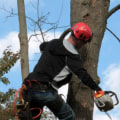If you are concerned about the health of your tree, you can contact an arborist for help. Arborists are professionals who care for trees and other woody plants. Arborists are considered tree doctors who specialize in tree care. This could include acting as a consultant to determine the type of trees to be used in landscape design, trimming trees for optimal health and growth, or diagnosing and treating trees with diseases.
Arborists also provide assistance with structural problems that arise with trees by working directly with customers or consulting landscaping companies. Arborists can help people learn and understand what nutrients help trees grow, what diseases infest trees, and how a tree's immune system works. In short, an arborist is a tree expert who has studied the science of arboriculture. These specialists care for the trees and make sure that these majestic plants can live in harmony with us humans (as well as with our homes) safely.
Arborists can take care of the following responsibilities. Usually, an arborist focuses on caring for individual trees, often on private properties. Arborists can be divided into two broad categories; practicing arborists and consulting arborists. A practicing arborist, also known as a commercial arborist, is the type of tree care provider that many people first think of when they hear the word arborist.
A practicing arborist can offer tree care services such as pruning, planting, removal, pesticide application and fertilization. A person who prunes trees is also an arborist. As mentioned, arborists are trained in pruning and removing trees in confined spaces. This includes trimming trees that protrude from the house and power lines.
An arborist (or tree surgeon or tree pruner and pruner, as they may sometimes be called) is an arboriculture practitioner. These are professional professionals who can grow, manage, care for and rehabilitate trees and shrubs. There are also foresters who are professionals who specialize in managing an entire forest and may be responsible for harvesting wood, while an arborist specializes in individual trees. Arborists may be hired by a member of a dispute to identify factual information about trees useful to that member of the dispute, or they may be hired as expert witnesses who provide impartial scientific knowledge in a court case.
Arborists can provide suitable solutions, such as pruning trees to maintain health and good structure, for aesthetic reasons, and allowing people to walk under them (a technique often known as canopy lifting) or keeping them away from wires, fences and buildings (a technique known as crown). reduction). A professional arborist who applies a pesticide to a rental tree must have a license from the State of Minnesota. They bring a wealth of experience and understanding of how to care for trees and provide long-term value to you and your property, as well as surrounding communities.
He is a diagnostic expert with extensive experience in the areas of tree health care, tree risk assessment and tree value assessment. An arborist can help you plant juvenile trees to ensure healthy growth or maintain your existing adult trees. The forester will make decisions about when and how to plant and harvest trees to meet their management objectives. In addition to providing general recommendations on tree care, consultant arborists can offer tree value assessments, tree risk assessments, expert witness testimony, and litigation support services for lawyers, insurance companies, homeowners, and managers of properties.
These professionals must also undergo a thorough examination that will allow them to become certified Arborists if they pass. Pruning trees regularly can improve their overall health and growth, and an arborist will know exactly how to prune your specific variety of tree to ensure it thrives. A certified arborist can help assess the condition of the tree and determine if you need to prune or not. An arborist can recommend which trees will thrive in your climate and which will not be invasive or harmful to other plants and wildlife.
The science of horticulture covers a broader spectrum than that of an arborist, whose concern is trees or shrubs. Some commonly offered services are considered unacceptable by modern arboriculture standards and can seriously damage, deface, weaken or even kill trees. This means that a tree that can be considered a hazard to a property owner cannot be considered a hazard by another owner. .
.






